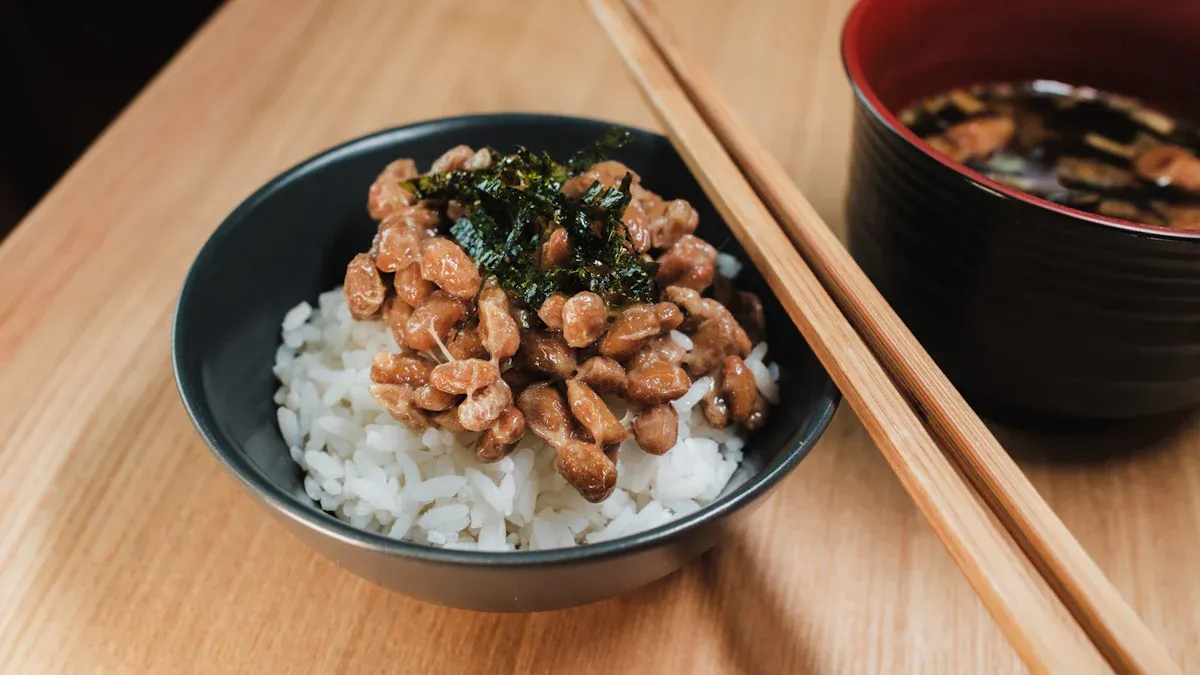The Power of Natto’s Flavor A 2025 Umami Guide
Table of Contents

Natto is a food of contrasts. In Japan, statistics show about 90% of residents eat it, yet for others, natto’s flavor remains a culinary challenge. The secret to its savory depth is umami, a powerful taste created during fermentation. Its strong aroma and sticky texture are also essential parts of the experience. Growing interest in the health benefits of natto drives its popularity in new markets.
Global Interest on the Rise 📈
An increasing number of consumers in these countries are trying natto:
- United States
- United Kingdom
- Germany
THE SCIENCE OF NATTO’S UMAMI
The unique power of natto comes from a fascinating scientific process. The transformation from a simple soybean to a complex superfood involves specific bacteria, chemical reactions, and unique compounds. Understanding this science is the first step to appreciating its deep, savory character.
THE FERMENTATION FACTOR
The key to natto is fermentation. A specific bacterium, Bacillus subtilis, drives this entire process. This microorganism consumes the proteins and sugars within cooked soybeans. During this metabolic activity, the bacterium breaks down large soy proteins into smaller components. The most important of these components is glutamic acid. This amino acid is the direct source of the fifth taste, umami. The more the soybeans are fermented, the more glutamic acid is produced, resulting in a richer, more savory product. This controlled, fermented process is what gives natto its signature taste.
UMAMI VS. BEAN TASTE
Many people first notice a mild, nutty, or even bland bean taste when trying natto. This is the flavor of the base soybean. The true experience, however, lies in the deep, earthy savoriness that follows. Scientific studies help explain this complex profile. Research using sensory evaluation panels identifies the various volatile organic compounds that create natto’s distinct aroma and taste. Studies also show that free amino acids are crucial to how people perceive the taste of these fermented soybeans.
The initial bean taste is quickly overshadowed by a wave of other flavors created during fermentation. These new tastes come from a variety of volatile compounds.
- Pyrazines and sulfur compounds: These molecules help mask the raw beany smell and create natto’s characteristic pungent aroma.
- Ketones: Often created from amino acid breakdown, these are generally desirable flavor attributes.
- Esters: These compounds give the fermented soybeans sweet, floral, and fruity notes. One specific ester, methyl phenylacetate, provides a honey-like aroma.
- Alcohols: Certain alcohols can even contribute a flavor reminiscent of soy sauce.
THE STICKINESS SENSATION
The famous sticky strings of natto, known in Japanese as neba-neba, are more than just a unique texture. They are a key part of the flavor experience. These viscous threads consist of polyglutamic acid, or PGA.
The Chemistry of Stickiness 🧪
PGA is a natural biopolymer made of repeating glutamic acid units, with the chemical formula
(C5H7NO3)n. Its structure is similar to a protein polymer. This substance not only creates the sticky mouthfeel but also enhances the perception of umami and contributes to a feeling of fullness.
The presence of PGA means that the very substance creating the texture is built from the same molecule that delivers the savory taste. This connection makes the stickiness an essential component of the complete natto’s flavor experience.
DECODING NATTO’S FLAVOR EXPERIENCE

Understanding natto’s flavor goes beyond its umami taste. The complete experience involves a trio of sensory inputs: its powerful aroma, its unique texture, and the cultural lens through which people view it. Decoding these elements helps explain why this fermented food inspires such strong reactions.
THE AROMA PROFILE
The first thing many people notice about natto is its strong, pungent smell. This aroma is a direct result of the fermentation process. Specific chemical compounds create this signature scent. Scientists have identified several key molecules that contribute to the complex smell.
- Pyrazines: These are major contributors to the aroma. Compounds like 2,5-dimethylpyrazine and tetramethyl pyrazine give natto its characteristic roasted, nutty, and earthy notes.
- Sulfur Compounds: Molecules like dimethyldisulphide help mask the raw beany smell of the soybeans.
- Acids and Ketones: 2-methylbutanoic acid and 3-hydroxybutanone add sharp and sometimes cheesy notes to the overall profile.
- Ammonia: A small amount of ammonia is also produced, adding to the pungent quality of the fermented soybeans.
These compounds work together. They create an aroma that is intense and unfamiliar to many, yet it signals a rich and deeply savory food to those who enjoy it.
TEXTURE’S ROLE IN TASTE
The sticky, stringy texture of natto is inseparable from its taste. This stickiness, or neba-neba, coats the tongue. This action helps the umami compounds linger, making the savory flavor last longer. However, people can modify this texture to adjust the experience. Adding sauces and toppings changes both the mouthfeel and the overall taste.
Many classic additions make natto more approachable. Soy sauce and mustard cut through the richness. Sesame oil can lessen the pungent aroma. Other toppings introduce new textures and flavors that complement the beans. Popular choices include crunchy daikon radish, fresh spring onions, spicy kimchi, or briny Japanese pickles. These pairings create a more balanced and dynamic dish.
CULTURAL PERCEPTION
How a person perceives natto’s flavor often depends on their cultural background. In Japan, natto has a long history. People traditionally made it by wrapping boiled soybeans in rice straw, which naturally contained the right bacteria. In the city of Mito, natto is a celebrated local specialty. Restaurants there serve it all day in various creative dishes, showing a deep regional appreciation.
For first-time consumers in Western countries, natto’s ‘distinctive taste, aroma, and texture’ present a ‘primary challenge.’ This sensory barrier can be surprising for those unfamiliar with traditional Japanese foods.
However, perceptions are changing. A growing interest in plant-based diets and functional foods is driving new consumers to try natto. While the initial experience can be a hurdle, many people learn to appreciate it. They are often motivated by its well-documented health benefits. This shift shows that understanding and familiarity can transform a challenging food into a beloved superfood.
HOW TO MASTER AND ENJOY NATTO

People can learn to master natto’s complex flavor through preparation. Simple techniques and pairings transform the experience. These methods make the fermented food more approachable and enjoyable for everyone.
THE 50-STIR METHOD
A popular Japanese culinary custom involves stirring natto vigorously. Some people debate the optimal number of stirs, with suggestions ranging from 30 to over 300. The stirring action aerates the sticky biofilm and helps release more glutamic acid. This process can create a fluffier texture and a deeper savory flavor. While there is no scientific proof that a specific number of stirs is best, the practice itself is a key step in preparing natto.
CLASSIC UMAMI PAIRINGS
Classic pairings are essential for enjoying natto. The most common dish is Natto Gohan, a traditional Japanese breakfast staple. This simple meal involves serving natto over steamed rice. People often add a soy sauce-based tare, spicy karashi mustard, and chopped green onions. This combination is a beloved Japanese breakfast staple.
Umami Synergy 🔬
Pairing natto with certain ingredients creates a powerful umami synergy. Natto contains glutamate. When combined with foods rich in inosinates, like dried bonito flakes (katsuobushi), the savory taste can be up to eight times stronger.
Other classic additions change the texture and taste. A raw egg yolk, for example, gives the dish a light, creamy texture and mellows the natto’s strong flavor.
| Classic Addition | Effect on Flavor & Texture |
|---|---|
| Soy Sauce & Mustard | Adds saltiness and a sharp kick. |
| Green Onions | Provides a fresh, crisp contrast. |
| Bonito Flakes | Boosts savory taste through synergy. |
| Raw Egg Yolk | Creates a creamy, mild experience. |
MODERN UMAMI BOOSTERS
Natto’s versatility extends into modern fusion cooking. Chefs and home cooks are incorporating this fermented food into non-Japanese dishes. These creative pairings introduce natto’s unique benefits to a wider audience. Some popular fusion ideas include:
- Spaghetti alla Natto Carbonara
- Ground Beef and Natto Tacos
- Cheese Pizza with a Sriracha Natto topping
These innovative recipes show that natto can add a savory, complex layer to many different types of cuisine.
Natto’s flavor is a direct result of its rich umami. This savory taste develops when the soybeans are fermented. People can appreciate this food by understanding its three core elements: its deep taste, pungent aroma, and unique sticky texture.
Unlock the Umami 💡
Try one of the suggested pairings or preparation methods. You can experience its full savory potential for yourself.
FAQ
What does natto taste like?
Natto offers a complex flavor. People first notice a mild, nutty bean taste. A deep, savory umami flavor quickly follows. The fermentation process creates this distinct earthy taste, which is the food’s main characteristic.
Is natto healthy?
Yes, natto is a highly nutritious food. It provides beneficial probiotics that support gut health. It is also one of the richest plant-based sources of Vitamin K2, a vitamin important for bone and heart health.
How can I make natto taste better?
People can improve natto’s flavor with simple additions. Stirring it vigorously is the first step to enhance its taste and texture.
Try these classic pairings:
- Soy sauce and karashi mustard
- Chopped green onions
- A raw egg yolk over rice
Why is natto so sticky?
The sticky strings consist of polyglutamic acid (PGA). The Bacillus subtilis bacteria produce this substance during fermentation. This texture, called neba-neba, helps the umami flavor coat the tongue and last longer.

Poseidon
Master of Nutritional Epidemiology, University of Copenhagen, Herbal Functional Nutrition Researcher
Focus: The scientific application of natural active ingredients such as Tongo Ali, Horny Goat Weed, and Maca to sexual health and metabolic regulation.
Core Focus:
Men: Use a combination of Tongo Ali (an energizing factor) + Maca (an energy reserve) to improve low energy and fluctuating libido.
Women: Use a combination of Horny Goat Weed (a gentle regulator) + Maca (a nutritional synergist) to alleviate low libido and hormonal imbalances.
Stressed/Middle-Aged Adults: This triple-ingredient synergy supports metabolism, physical strength, and intimacy.
Product Concept:
Based on traditional applications and modern research (e.g., Tongo Ali promotes testosterone-enhancing enzyme activity, and icariin provides gentle regulation), we preserve core active ingredients and eschew conceptual packaging—using natural ingredients to address specific needs.
Simply put: I'm a nutritionist who understands "herbal actives." I use scientifically proven ingredients like Tongo Ali, Epimedium, and Maca to help you make "sexual health" and "nutritional support" a daily routine.
